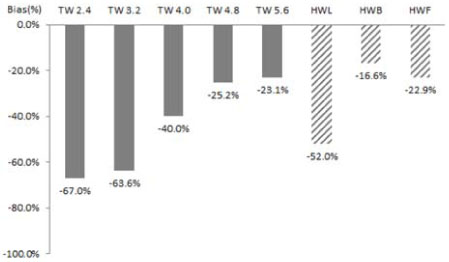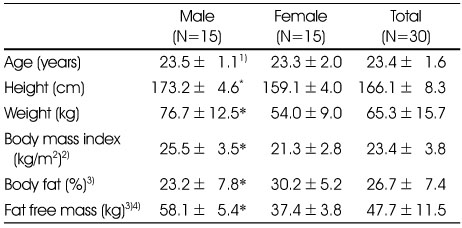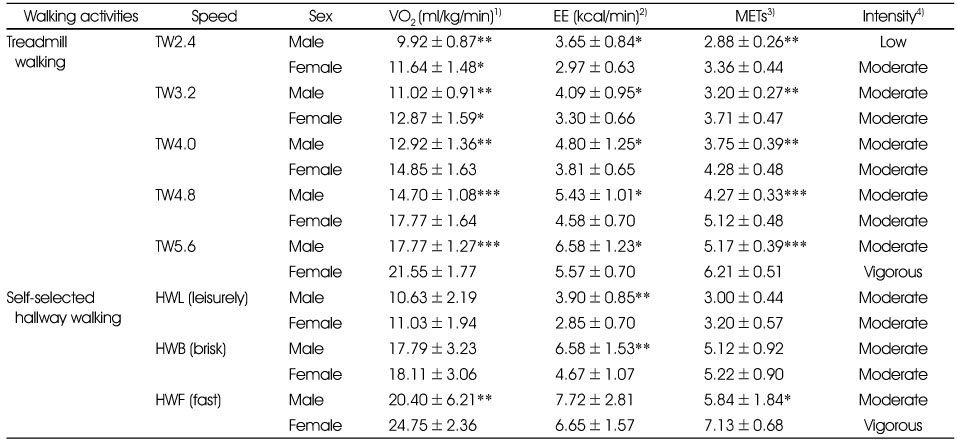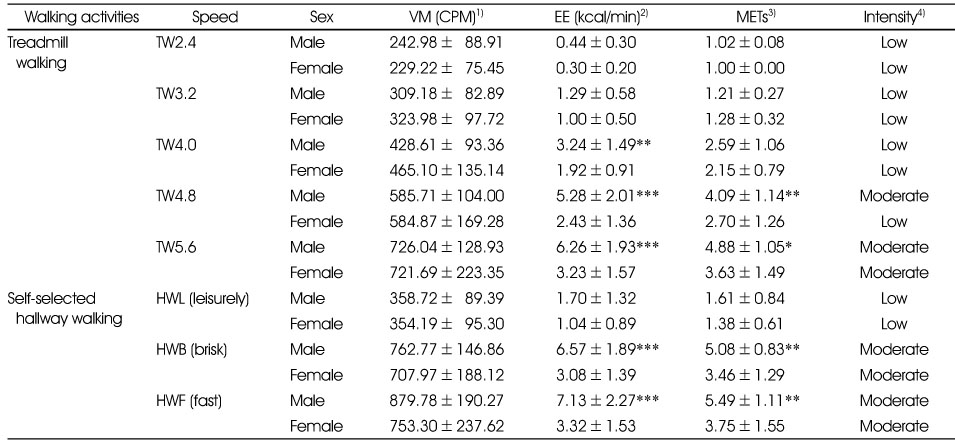References
1. Jang YH, Kim SH, Kim YS, Jung SH, Park J. The relationship between walking exercise and quality of life for Korean adults. J Digit converg 2013;11(5):325–334.
2. Qiu S, Cai X, Schumann U, Velders M, Sun Z, Steinacker JM. Impact of walking on glycemic control and other cardiovascular risk factors in type 2 diabetes: a meta-analysis. PLoS One 2014;9(10):e109767.
3. Lee KY, Shin W, Ji MJ. Health promotion research and the development of a walking exercise program. J Basic Sci 2014;31:93–106.
4. Barnett A, Cerin E, Vandelanotte C, Matsumoto A, Jenkins D. Validity of treadmill- and track-based individual calibration methods for estimating free-living walking speed and VO2 using the Actigraph accelerometer. BMC Sports Sci Med Rehabil 2015;7:29.
5. Han SW, Kong SA. The effect of backward walking and foreward walking on physical fitness in treadmill inclination for women. J coach dev 2006;8(3):269–276.
6. Korea Centers for Disease Control and Prevention. Korea Health Statistics 2014: Korea National Health and Nutrition Examination Survey (KNHANES VI-2) [Internet] Korea Centers for Disease Control and Prevention; 2015. cited 2016 Dec 12. Available from:
https://knhanes.cdc.go.kr/.
7. Choi HJ, Song JM, Kim EK. Assessment of daily steps, activity coefficient, body composition, resting energy expenditure and daily energy expenditure in female university students. J Korean Diet Assoc 2005;11(2):159–169.
8. Kim SH. A survey on daily physical activity level, energy expenditure and dietary energy intake by university students in Chungnam province in Korea. J Nutr Health 2013;46(4):346–356.
9. Park Y, Kim JH. Assessment of physical activity pattern, activity coefficient, basal metabolic rate and daily energy expenditure in female university students. Korean J Community Nutr 2013;18(1):45–54.
10. You JS, Chin JH, Kim MJ, Chang KJ. College students' dietary behavior, health-related lifestyles and nutrient intake status by physical activity levels using international physical activity questionnaire (IPAQ) in Incheon area. Korean J Nutr 2008;41(8):818–831.
11. Park JY, Kim NH. Relationships between physical activity, health status, and quality of life of university students. J Korean Public Health Nurs 2013;27(1):153–165.
12. Kang DW, Choi JS, Mun KR, Tack GR. Estimation of energy expenditure of walking and running based on triaxial accelerometer and physical information. Korean J Sport Biomech 2008;18(4):109–114.
13. Lee MY. Criterion and convergent validity evidences of an Accelerometer and a Pedometer. Korean J Meas Eval Phys Educ Sport Sci 2012;14(2):1–13.
14. Miller NE, Strath SJ, Swartz AM, Cashin SE. Estimating absolute and relative physical activity intensity across age via accelerometry in adults. J Aging Phys Act 2010;18(2):158–170.
15. Lyden K, Kozey SL, Staudenmeyer JW, Freeson PS. A comprehensive evaluation of commonly used accelerometer energy expenditure and MET prediction equations. Eur J Appl Physiol 2011;111(2):187–201.
16. Peterson NE, Sirard JR, Kulbok PA, Deboer MD, Erickson JM. Validation of accelerometer thresholds and inclinometry for measurement of sedentary behavior in young adult university students. Res Nurs Health 2015;38(6):492–499.
17. Plotnik M, Azrad T, Bondi M, Bahat Y, Gimmon Y, Zeiling G. Self-selected gait speed-over ground versus self-paced treadmill walking, a solution for a paradox. J Neuroeng Rehabil 2015;12:20.
18. Hall KS, Howe CA, Rana SR, Martin CL, Morey MC. METs and accelerometry of walking in older adults: standard versus measured energy cost. Med Sci Sports Exerc 2013;45(3):574–582.
19. Schrack JA, Simonsick EM, Ferrucci L. Comparison of the Cosmed K4b(2) portable metabolic system in measuring steady-state walking energy expenditure. PLoS One 2010;5(2):e9292.
20. Vanhelst J, Mikulovic J, Bui-Xuan G, Dieu O, Blondeau T, Fardy P. Comparison of two actigraph accelerometer generations in the assessment of physical activity in free living conditions. BMC Res Notes 2012;5(1):187.
21. Actigraph Support Center. What is VM (Vector Magnitude)? [Internet] Actigraph Support Center; 2016. cited 2016 Nov 28. Available from:
http://actigraphcorp.com.
22. Ainsworth BE, Haskell WL, Whitt MC, Irwin ML, Swartz AM, Strath SJ. Compendium of physical activities: an update of activity codes and MET intensities. Med Sci Sports Exerc 2000;329 suppl. :S498–S504.
23. Ministry of Health and Welfare. The physical activity guide for Koreans Ministry of Health and Welfare; 2013.
24. Kang IW, Cho WJ. The influence on mental health status and health-related quality of life in middle-aged women by the regular walking exercise. J Korea Soc Wellness 2016;11(1):207–215.
25. Choi YY, Choi SB, Kim SG. The relationship between physical self-concept and subjective happiness according to walking exercise participation type. Korean J Sport 2011;9(2):1–12.
26. Jeon JS. Walking efficiency by obesity. Proceedings of The 8th Korea Walking Festival Seminar 2002. 10. 25. p. 94–107.
27. Lee MH, Kim DY, Nam DH. Validation of the GT1M and GT3X Accelerometers for assessment of physical activity. Korean J Meas Eval Phys Educ Sport Sci 2012;14(2):61–71.
28. Webb P. Energy expenditure and fat-free mass in men and women. Am J Clin Nutr 1981;34(9):1816–1826.
29. An JH. The model for the walking and running program for the health of the aged. J Korean Phys Soc 1996;35(3):299–308.
30. Hunnicutt JL, Aaron SE, Embry AE, Cence B, Morgan P, Bowden MG, et al. The effects of power training in young and older adults after stroke. Stroke Res Treat 2016;10.1155/2016/7316250.
31. Bayle N, Patel AS, Crisan D, Guo LJ, Hutin E, Weisz DJ. Contribution of step length to increase walking and turning speed as a marker of Parkinson's disease progression. PLoS One 2016;11(4):e0152469.
32. Seale JL, Rumpler WV. Synchronous direct gradient layer and indirect room calorimetry. J Appl Physiol 1997;83(5):1775–1781.
33. Jeong SM, Kim TH, Park CH, Kim HG, Jekal YS. Review and introduction of physical activity assesment actigraph. J Exerc Sport Sci 2013;19:31–41.
34. Freedson PS, Melanson E, Sirard J. Calibration of the computer science and applications, Inc. accelerometer. Med Sci Sports Exerc 1998;30(5):777–781.
36. Park DH, Kim CS, Kim KJ. Consideration about physical activity guideline and exercise intensity for adult. Exerc Sci 2015;24(2):100–107.
37. Lee MY, Choi JY. Accuracy of wearable devices to estimate physical activity levels. Korean J Meas Eval Phys Educ Sport Sci 2015;17(2):49–60.








